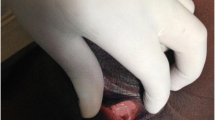Abstract
Objectives
Evaluation of double cross plasty for management of obstructive or non obstructive transverse vaginal septum.
Methods
13 patients presented either as cryptomenorrhoea or as infertility/dyspareunia were diagnosed to have transverse vaginal septum. They were subjected to double cross plasty and were subsequently followed up for period of two years.
Results
13 patients presented either as cryptomenorrhoea or infertility/dyspareunia. Nine patients had transverse vaginal septum at low level, three at midlevel, and one had high-level septum. The thickness of septum was 1–3 cms in 12 patients. Double cross plasty was performed in all patients. One patient with high vaginal septum which was thick needed bilateral labial flaps. All patients were followed up to period of 2 years and none had restenosis. Three patients had pregnancies with vaginal delivery in two of them.
Conclusion
Double cross plasty for management of transverse vaginal septum is a better technique compared with currently used surgical methods. In our series, it did not cause restenosis and some of our patients were able to deliver vaginally.



Similar content being viewed by others
References
Chitale VR, Sardesai SP, et al. The double crossplasty: a new technique for transverse vaginal septum. J Obstet Gynecol India. 1996;46(6):859–61.
John AR, Lesley LB. Surgery for anomalies of the mullerian ducts; Te Linde’s Operative Gynecology. 10th ed. New York: Wolters Kluwer; 2010. p. 539.
Fayez GS, Ramez S, Zoury A. Transverse vaginal septum : a clinicopathologic. Eval Obstet Gynecol. 1979;54(3):278–83.
Bradley SH, John AR. Preoperative dilatation to facilitate repair of the high transverse vaginal septum. Fertil & Steril. 1992;57(6):1351–3.
Franz W, Klaus B, Babetta S, et al. ‘Z’ plasty of the transverse vaginal septum using Garcia’s procedure and the Grunberger modification. Fertil Steril. 2003;79(3):608–12.
John AR, Howard AZ, et al. Pregnancy success following surgical correction of imperforate hymen and complete transverse vaginal septum. Obstet Gynecol. 1982;59:448–51.
Compliance with ethical requirements and Conflicts of interests
All procedures followed were in accordance with the ethical standards of the responsible committee on human experimentation (institutional and national) and with the Helsinki Declaration of 1975, as revised in 2008(5). Informed consent was obtained from all patients for the surgery. An ethical clearance has also been taken from the institutional ethical committee. The authors of the article Dr Suman Pradeep Sardesai, Dr Raju Dabade, Dr Vinayak Chitale declare that they have no conflicts of interest.
Author information
Authors and Affiliations
Corresponding author
Rights and permissions
About this article
Cite this article
Sardesai, S.P., Dabade, R. & Chitale, V. Double Cross Plasty for Management of Transverse Vaginal Septum: A 20-Year Retrospective Review of Our Experience. J Obstet Gynecol India 65, 181–185 (2015). https://doi.org/10.1007/s13224-014-0542-3
Received:
Accepted:
Published:
Issue Date:
DOI: https://doi.org/10.1007/s13224-014-0542-3




